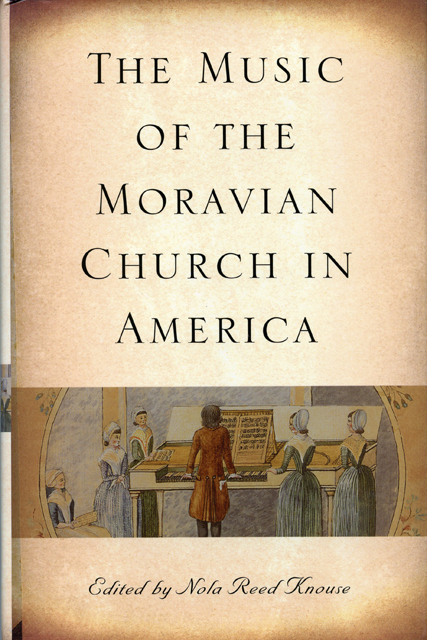Book contents
- Frontmatter
- Contents
- List of Illustrations
- Foreword
- Preface
- Acknowledgments
- 1 The Moravians and Their Music
- 2 Moravian Worship: The Why of Moravian Music
- 3 Hymnody of the Moravian Church
- 4 Moravian Sacred Vocal Music
- 5 The Organ in Moravian Church Music
- 6 The Role and Development of Brass Music in the Moravian Church
- 7 The Collegia Musica: Music of the Community
- 8 Music in Moravian Boarding Schools through the Early Nineteenth Century
- 9 The Piano among the Moravians in the Eighteenth and Nineteenth Centuries: Music, Instruction, and Construction
- 10 Moravian Music: Questions of Identity and Purpose
- Appendix 1 Biographical Sketches
- Appendix 2 A Moravian Musical Timeline
- Bibliography
- List of Contributors
- Index
- Eastman Studies in Music
9 - The Piano among the Moravians in the Eighteenth and Nineteenth Centuries: Music, Instruction, and Construction
Published online by Cambridge University Press: 10 March 2023
- Frontmatter
- Contents
- List of Illustrations
- Foreword
- Preface
- Acknowledgments
- 1 The Moravians and Their Music
- 2 Moravian Worship: The Why of Moravian Music
- 3 Hymnody of the Moravian Church
- 4 Moravian Sacred Vocal Music
- 5 The Organ in Moravian Church Music
- 6 The Role and Development of Brass Music in the Moravian Church
- 7 The Collegia Musica: Music of the Community
- 8 Music in Moravian Boarding Schools through the Early Nineteenth Century
- 9 The Piano among the Moravians in the Eighteenth and Nineteenth Centuries: Music, Instruction, and Construction
- 10 Moravian Music: Questions of Identity and Purpose
- Appendix 1 Biographical Sketches
- Appendix 2 A Moravian Musical Timeline
- Bibliography
- List of Contributors
- Index
- Eastman Studies in Music
Summary
One of the first instruments transported to the New World by the Moravians was a spinet, which arrived on January 25, 1744. The instrument suffered considerable damage during the voyage, but was quickly repaired and used in the following day's service. The Moravian scholar William Reichel documents that in 1792 the Moravian Young Ladies’ Seminary in Bethlehem, Pennsylvania, owned seven pianos and clavichords, and in 1805 an invoice for tuning harpsichords suggests that it might have owned at least as many of these instruments. In Maximilian Wied's diary, which chronicles his travels in North America from 1832 through 1834, he recalls visiting the Moravian Young Ladies’ Seminary in Bethlehem and seeing ten rooms, each with a piano. It appears that this instrument was popular at the Seminary, which by 1866 owned nearly forty pianos.
Although Moravians have a long history of composing and making music, by and large they did not devote their creative efforts to composing music for stringed keyboard instruments. Given the limited number of keyboard compositions written by a small group of composers, we might conclude that the harpsichord, clavichord, and piano were not among the instruments favored by the Moravians. On the contrary, the Moravians placed considerable emphasis on teaching and learning to play, on building instruments of quality, and (to a lesser extent) composing music for keyboard instruments.
Moravian Composers of Piano Music
Although Moravians played spinets, harpsichords, and clavichords, their known stringed keyboard compositions are limited to music for the piano. Johann Gottfried Gebhard (1755–after 1799), John Gambold, Jr. (1760–95), and Christian Ignatius LaTrobe (1758–1836), living in the late eighteenth and early nineteenth centuries, composed sonatas for the piano. Even though their primary life's work and commitment was to the church as ministers and/or educators, their sonatas reveal their unusual compositional skill. Although Gebhard, Gambold, and LaTrobe received their training in Germany, their piano sonatas exhibit some style characteristics unlike those of other classical-era composers.
- Type
- Chapter
- Information
- The Music of the Moravian Church in America , pp. 228 - 251Publisher: Boydell & BrewerPrint publication year: 2009



